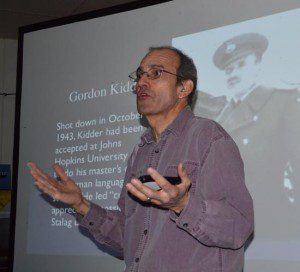
I had just completed one of my talks on The Great Escape. It was about an hour’s presentation at the Legion hall in Port Carling (in Muskoka) last Saturday. I asked someone to turn up the lights, so I could see the audience and take some questions. It’s in those moments that I prepare myself for a tough question and maybe some criticism. And I’m OK with that. Then, a man in the front row put up his hand to speak and the room went silent.
“I spent months in a POW camp just outside Munich during the war,” Jack Patterson said quietly, but steadily. “It was exactly the way you said.”
I walked over to him, shook his hand and asked him to stand and face the audience of about a hundred people. Then I asked if he would explain. He offered an abbreviated story of his capture by German troops in Normandy in July 1944.
Ultimately, he said, he and other members of his Algonquin Regiment (from central Ontario) wound up at a place called Stalag (German for Straflager, or prison) VII-A at Moosburg, near Munich. He was tossed into a prison compound there with Americans, South Africans, British and Arab troops – all prisoners of war. He called the compound “a real league of nations.”
When he was done, everyone in the hall stood and applauded his service. Later, Patterson offered me a number of additional anecdotes – including deprivation, isolation, and near annihilation – as a prisoner of war. I’d heard many of his experiences before. But the one flashback he shared that stood out for me was his liberation. Patterson said the U.S. Third Army under Gen. George Patton freed him and his fellow Algonquins. On May 5, 1945, with the war ending in Europe, all POWs were taken to a German aerodrome for transport back home.
“We boarded Lancaster bombers to take us back to England,” he said. They weren’t made for carrying troops, so I was sitting on a (navigator’s) desk where I could look out a window, and it wasn’t long before I saw the white cliffs of Dover. … It was great to have our feet back in England.”
Another encounter from that very same audience, on Saturday afternoon, occurred when a man approached me with a plastic bag. It contained a book, entitled “Drei Tage I’m September” (Three Days in September), written by German author Cay Rademacher. The man with the plastic bag was Philip Gunyon and the book was about the three days surrounding the sinking of the British cruise vessel S.S. Athenia by a German U-boat on Sept. 3, 1939, the very day Britain declared war on Germany. Gunyon opened the book to the photo section and pointed to an image of a woman and her three children. Gunyon’s family (exluding his father) had all been aboard Athenia when it was torpedoed.
“I was seven when it happened,” Gunyon said.
The book details the events leading up to submarine commander Fritz-Julius Lemp’s decision to fire a torpedo from U-30 at Athenia, mistaking the passenger liner for a British armed merchant cruiser. The ship was sailing with 1,100 passengers aboard (60 kilometres off the coast of Ireland) on a regularly scheduled passage from Glasgow to Montreal. Though the passenger vessel remained afloat for 14 hours after the attack, 98 passengers and 19 crew died in the wreck.
“Liner Athenia torpedoed and sunk,” read the headline in the Halifax Herald on Sept. 4. And across the centre of the page, “Empire at War!”
History records that a Canadian girl, 10-year-old Margaret Hayword, was killed in the sinking. She was the perhaps the first Canadian to die, the result of enemy action in the Second World War. Philip Gunyon, showing me the book in its original German script, pointed out that his mother, two siblings and he had survived.
One more surprise awaited me Saturday afternoon at the Port Carling Legion. After my talk about The Great Escape by tunnel from German POW camp Stalag Luft III, another man approached me to comment on the book.
“My name is Frank Pengelly. I’m a cousin of Tony Pengelly, the man in charge of forging documents in the Great Escape,” he said.
He explained that his cousin, as I described in the book, had led a stable of 100 artists and calligraphers in the creation of phony documents (looking exactly like originals) that would allow the Great Escapers to get through train stations and across borders because they had look-alike passes and visas.
“The story is exactly as you wrote it,” Pengelly said.
Saturday afternoon proved to be one of those remarkable moments one imagines when the stars align. I had chosen to speak in a room where much of the history I was recounting had been experienced first-hand by some of those present. I marveled at the history. I reveled in the coincidence.